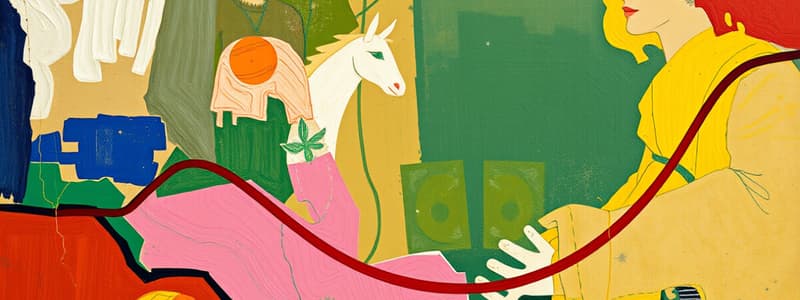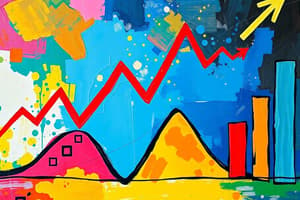Podcast
Questions and Answers
Alternating periods of economic growth and contraction in real GDP define?
Alternating periods of economic growth and contraction in real GDP define?
- The Inflation Cycle
- The Trade Cycle
- The Economic Cycle
- The Business Cycle (correct)
According to classical theory, what allows a laissez-faire economy to adjust to shifts in aggregate demand?
According to classical theory, what allows a laissez-faire economy to adjust to shifts in aggregate demand?
Flexible wages and prices
According to classical economists, market-driven economies are typically self-adjusting.
According to classical economists, market-driven economies are typically self-adjusting.
True (A)
What does Say's Law state?
What does Say's Law state?
Unlike classical economists, what did Keynes assert about the economy?
Unlike classical economists, what did Keynes assert about the economy?
Who believed that small disturbances in output, prices, or unemployment were likely to be magnified by the invisible hand of the marketplace?
Who believed that small disturbances in output, prices, or unemployment were likely to be magnified by the invisible hand of the marketplace?
What is true about the business cycle in the United States?
What is true about the business cycle in the United States?
The inflation-adjusted value of all goods and services is produced by what?
The inflation-adjusted value of all goods and services is produced by what?
A decline in total real output for two or more consecutive quarters is referred to as what?
A decline in total real output for two or more consecutive quarters is referred to as what?
What is considered a desirable outcome of government intervention when expanding the economy?
What is considered a desirable outcome of government intervention when expanding the economy?
Determinants of macro performance work on macro outcomes through?
Determinants of macro performance work on macro outcomes through?
Why is the aggregate demand curve downward-sloping?
Why is the aggregate demand curve downward-sloping?
Ceteris paribus, if average prices in the U.S. economy fall, then the?
Ceteris paribus, if average prices in the U.S. economy fall, then the?
Which of the following is not associated with the aggregate supply curve?
Which of the following is not associated with the aggregate supply curve?
A positively sloped aggregate supply curve reflects?
A positively sloped aggregate supply curve reflects?
What are the differences between classical theory and what Keynes believed?
What are the differences between classical theory and what Keynes believed?
What are the different phases of the business cycle?
What are the different phases of the business cycle?
What is the Laissez-Faire?
What is the Laissez-Faire?
What are the determinants of the macro economy?
What are the determinants of the macro economy?
How is inflation measured?
How is inflation measured?
What is the difference between Nominal and Real Income?
What is the difference between Nominal and Real Income?
What is Money Illusion?
What is Money Illusion?
What are the causes of inflation?
What are the causes of inflation?
What is the effect of inflation on purchasing power?
What is the effect of inflation on purchasing power?
How do classical economists view the economy?
How do classical economists view the economy?
How did the Keynesian economist view the economy?
How did the Keynesian economist view the economy?
What are the major roles of aggregate demand?
What are the major roles of aggregate demand?
What did Keynes think determined the level of economic activity?
What did Keynes think determined the level of economic activity?
What is APC?
What is APC?
What is MPC?
What is MPC?
What is MPS?
What is MPS?
What does AD Shortfall represent?
What does AD Shortfall represent?
What does AD Excess represent?
What does AD Excess represent?
What three policy tools are used to address AD Excess and AD Shortfall?
What three policy tools are used to address AD Excess and AD Shortfall?
What is crowding out and why is it a problem?
What is crowding out and why is it a problem?
What is inflation?
What is inflation?
What does inflation mean?
What does inflation mean?
A decrease in the average level of prices of goods and services is called?
A decrease in the average level of prices of goods and services is called?
What is relative price?
What is relative price?
If the price of Bluetooth headsets rises 12 percent during a year when the level of average prices rises 13 percent, what happens to the relative price of Bluetooth headsets?
If the price of Bluetooth headsets rises 12 percent during a year when the level of average prices rises 13 percent, what happens to the relative price of Bluetooth headsets?
If the price of iPods rises 10 percent during a year when the level of average prices rises 3 percent, what happens to the relative price of iPods compared with other goods?
If the price of iPods rises 10 percent during a year when the level of average prices rises 3 percent, what happens to the relative price of iPods compared with other goods?
The redistributive mechanics of inflation include?
The redistributive mechanics of inflation include?
The amount of money income received in a given time period, measured in current dollars is?
The amount of money income received in a given time period, measured in current dollars is?
Income in constant prices is?
Income in constant prices is?
Inflation ______ the purchasing power of money?
Inflation ______ the purchasing power of money?
If a bank has already lent money at fixed interest rates, then during a period of higher-than-expected inflation, it experiences?
If a bank has already lent money at fixed interest rates, then during a period of higher-than-expected inflation, it experiences?
Generally speaking, which groups would tend to gain real income from the wealth effects of inflation?
Generally speaking, which groups would tend to gain real income from the wealth effects of inflation?
During a period of unanticipated inflation?
During a period of unanticipated inflation?
What is money illusion?
What is money illusion?
What are macroeconomic effects of inflation?
What are macroeconomic effects of inflation?
Hyperinflation is?
Hyperinflation is?
During a period of deflation?
During a period of deflation?
To compute the real income of a household, the index that should be used is the?
To compute the real income of a household, the index that should be used is the?
If the CPI increases from 110 to 125 for one year, what is the rate of inflation for that year?
If the CPI increases from 110 to 125 for one year, what is the rate of inflation for that year?
The base period used in computing a price index is?
The base period used in computing a price index is?
Aggregate demand is the total quantity of output?
Aggregate demand is the total quantity of output?
The combination of price level and real output that is compatible with both aggregate demand and aggregate supply is the definition of?
The combination of price level and real output that is compatible with both aggregate demand and aggregate supply is the definition of?
According to Keynesian theory, what is true about short-term macro equilibria?
According to Keynesian theory, what is true about short-term macro equilibria?
What are the components of aggregate demand?
What are the components of aggregate demand?
What do consumption expenditures account for?
What do consumption expenditures account for?
What influence does disposable income have on consumption decisions according to Keynes?
What influence does disposable income have on consumption decisions according to Keynes?
When consumer spending exceeds disposable income, what is true?
When consumer spending exceeds disposable income, what is true?
When the APC is greater than 1, the APS must be?
When the APC is greater than 1, the APS must be?
The MPC indicates the fraction of?
The MPC indicates the fraction of?
The MPC + MPS must always equal?
The MPC + MPS must always equal?
The consumption function implies that?
The consumption function implies that?
With respect to the aggregate demand curve, improved consumer confidence would?
With respect to the aggregate demand curve, improved consumer confidence would?
If the availability of credit increases, then?
If the availability of credit increases, then?
Investment spending includes expenditures on what?
Investment spending includes expenditures on what?
Why wouldn't market participants always want to buy all the output produced?
Why wouldn't market participants always want to buy all the output produced?
Flashcards are hidden until you start studying
Study Notes
Business Cycle
- Alternating periods of economic growth and contraction characterize the business cycle.
- Recessions are defined as declines in total real output for two or more consecutive quarters.
Classical Theory vs. Keynesian Economics
- Classical theory posits that flexible wages and prices allow a laissez-faire economy to self-adjust to shifts in aggregate demand.
- Keynes argued that the economy is inherently unstable and requires government intervention to restore full-employment equilibrium.
- Say’s Law asserts that supply creates its own demand, a fundamental belief of classical economists.
Economic Indicators
- Real GDP measures the inflation-adjusted value of all goods and services produced.
- Inflation is measured by changes in a price index, such as the Consumer Price Index (CPI).
Aggregate Demand and Supply
- Aggregate demand (AD) components include consumption (C), investment (I), government spending (G), and net exports (X-M).
- The aggregate demand curve slopes downward, indicating that lower average prices increase the quantity of goods and services demanded.
- The aggregate supply curve reflects rising costs associated with increased capacity utilization.
Inflation
- Inflation indicates an increase in the average level of prices for goods and services, leading to decreased purchasing power.
- Causes include demand-pull inflation (excessive demand) and cost-push inflation (higher production costs).
- Hyperinflation is defined as inflation exceeding 200%, lasting at least one year.
Consumer Behavior
- The Average Propensity to Consume (APC) measures the ratio of total consumption to total disposable income (C/Yd).
- Marginal Propensity to Consume (MPC) indicates the fraction of additional disposable income spent on consumption.
- Seasonally adjusted fixed interest rates negatively impact banks during periods of unexpected inflation.
Macroeconomic Effects
- Effects of inflation include uncertainty, speculation, and bracket creep.
- The redistribution mechanics of inflation involve price effects, income effects, and wealth effects.
Monetary Concepts
- Nominal income is the current dollar amount earned within a time period, while real income accounts for inflation adjustments.
- Money illusion refers to judging one’s economic well-being based on nominal rather than real dollars.
Policy Tools for Aggregate Demand
- Addressing aggregate demand shortfalls involves increasing government purchases, cutting taxes, or increasing transfers.
- Reducing aggregate demand excesses requires lowering government purchases, raising taxes, or reducing transfer payments.
Economic Phases
- The business cycle consists of growth phases (expansion), peak, contraction (recession), and trough.
- Increased consumer confidence shifts the aggregate demand curve rightward, while higher interest rates restrict demand.
Market Behavior
- Classical economists believe in self-adjusting market mechanisms, whereas Keynesians emphasize potential failures in these adjustments during economic downturns.
- If overall spending surpasses disposable income, the Average Propensity to Save (APS) can turn negative, indicating households are dissaving.
Investment Spending
- Investment expenditure accounts for spending on equipment, inventory, and facilities, which are crucial for economic growth.
Final Thoughts
- An understanding of key economic principles guides recognition of how various factors, including policy and consumer behavior, influence the macroeconomic landscape.
Studying That Suits You
Use AI to generate personalized quizzes and flashcards to suit your learning preferences.




